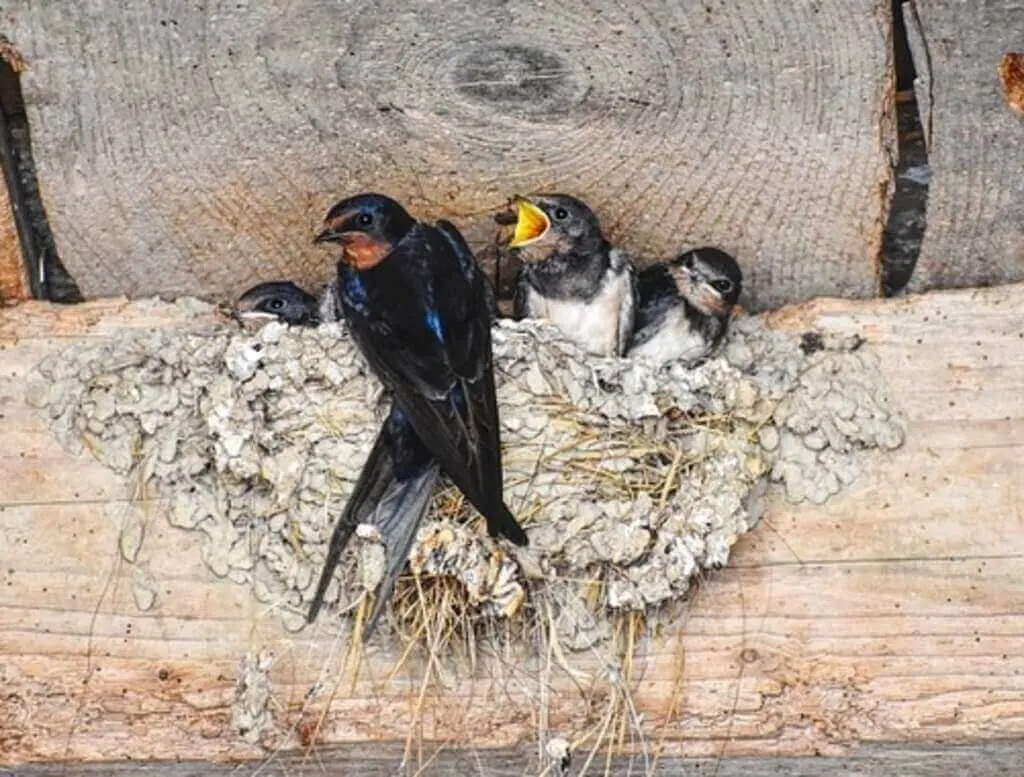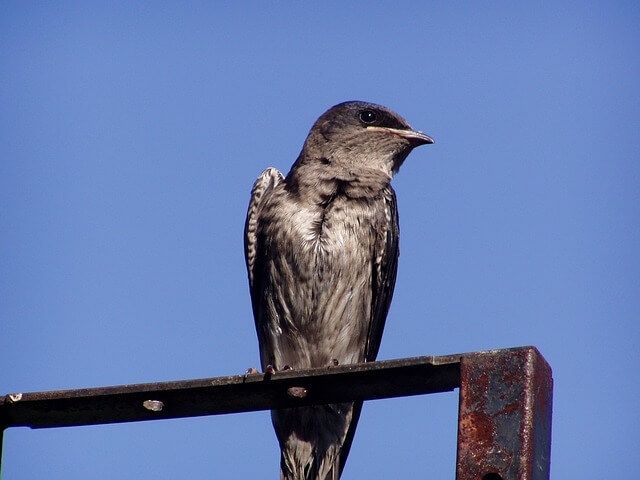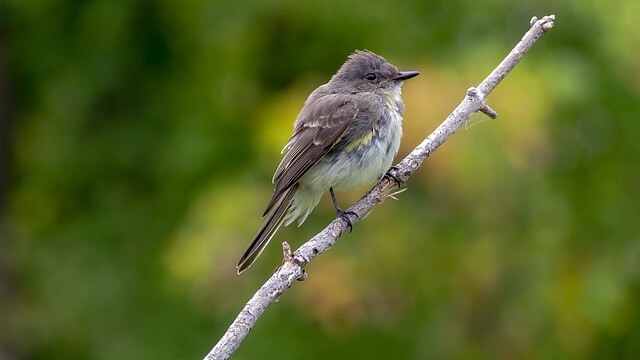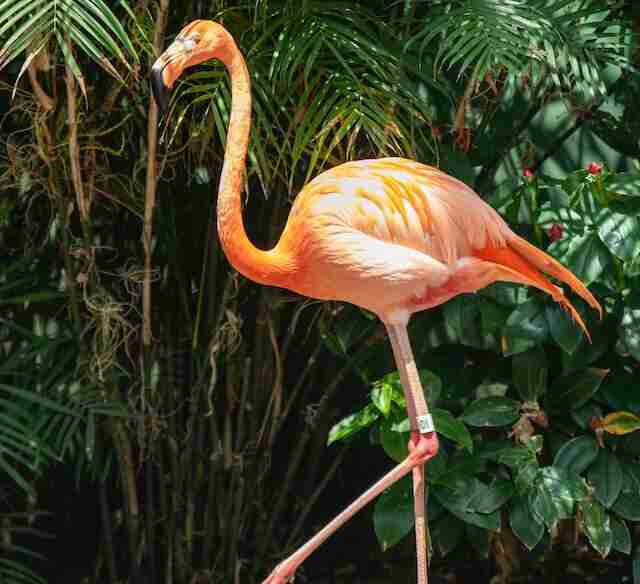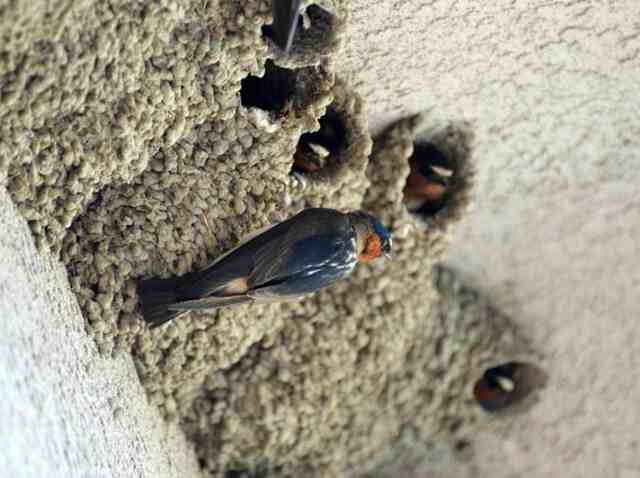Get ready to dive into the world of mud-slinging avian architects! Mud nests, the humble abodes of some of the most fascinating bird species on the planet, are more than just globs of dirt and muck – they’re masterpieces of engineering and survival.
In this blog post, we will explore the 14 types of birds that build mud nests, from their construction to their importance in the bird world. So, let’s delve into the fascinating world of avian architecture!
Table of Contents
- 1 Types of Birds That Build Mud Nests
- 2 Pros and Cons of Mud Nest Building
- 3 Material Used for Building a Mud Nest
- 4 How Birds Build Mud Nests?
- 5 Frequently Asked Questions
- 5.1 How to get rid of mud nest birds?
- 5.2 How to stop swallows nesting on your house?
- 5.3 How to stop swallows nesting under eaves?
- 5.4 When can you knock down a swallows nests?
- 5.5 How to keep swallows out of sheds?
- 5.6 How do you stop birds from building mud nests?
- 5.7 What bird builds a mud nest?
- 5.8 Birds that build nests on the side of the house
- 5.9 Birds that build mud nests on porches
- 5.10 How to identify a mud bird nest
- 5.11 Name the bird that builds a nest out of mud
- 5.12 Small birds that make mud nests
- 5.13 Birds that build mud houses
- 5.14 Birds that build mud nests under bridges
- 5.15 Bird nest with mud and straw
- 5.16 Birds that build mud nests in Texas
- 5.17 Oklahoma birds that build mud nests
- 5.18 Do sparrows make mud nests?
- 5.19 Birds that make mud nests in Texas
- 5.20 What birds make mud nests under bridges?
- 5.21 Birds that make clay nests
- 5.22 Birds that build mud nests in Georgia
- 5.23 What does a mud wren nest look like?
- 5.24 Why are birds putting mud on my house?
- 6 Author
Types of Birds That Build Mud Nests
Purple Martin
The Purple Martin (Progne subis) is the largest swallow species in North America. These charismatic birds are known for their iridescent blue-black plumage and their unique behaviors, including their aerial acrobatics.
Purple Martins are migratory birds, arriving in North America during the springtime. They usually live near water bodies to catch insects like mosquitoes, which they skillfully snatch right out of the air. During the breeding season, both males and females cooperate in choosing nesting sites.
Purple Martins typically nest inside cavities, which they readily use artificial houses, gourds, or natural hollows in trees for. They construct their nests using materials like mud, twigs, small rocks, and even seashells. The interior is lined with soft grasses and leaves to provide cushioning for their eggs.
| Characteristic | Details |
|---|---|
| Length | Approximately 7.5 to 7.9 inches (19-20 cm) |
| Weight | 1.9-2.6 ounces (55-75 grams) |
| Range | North America (breeding) and South America (winter) |
| Habitat | Open areas, near water bodies |
| Diet | Insects and aerial prey |
| Nest Structure | Cavities, gourds, or tree hollows |
| Materials Used | Mud, twigs, small rocks, seashells |
| Number of Broods | Typically 1-2 broods |
| Clutch Size | 4-6 eggs per clutch |
| Incubation Period | Around 15-18 days |
Common House Martin
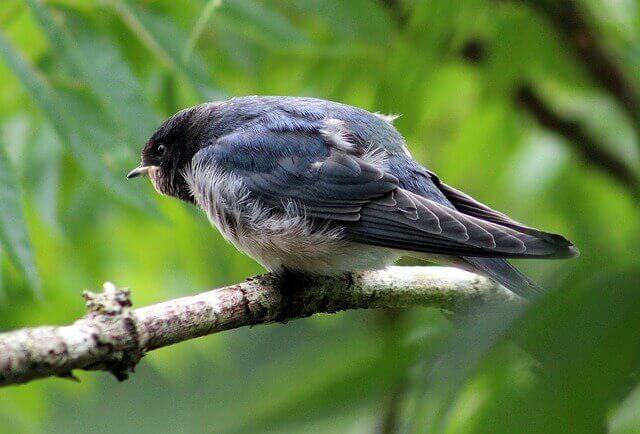
The Common House Martin, classified under the Hirundinidae family, display a wingspan of about 7 inches. They feature a sleek, aerodynamic body with iridescent blue-black upperparts and clean white underparts. These agile aviators are experts at capturing flying insects, making them a valuable natural pest control service, contributing to a healthier ecosystem.
For nesting, House Martins meticulously create cup-shaped homes using mud and their saliva. These nests are often attached to the eaves of houses or other structures. They’re not just functional but also built to endure various weather conditions.
In terms of migration, House Martins undertake an impressive journey, migrating from sub-Saharan Africa to Europe and Asia during the spring and summer. Their arrival is often associated with the changing of seasons.
| Characteristic | Details |
|---|---|
| Length | 5.0 inches (12.7 cm) |
| Weight | 18 g (0.65 oz) |
| Range | Native to Eurasia and Africa (also introduced in North America, Australia, New Zealand, and South America) |
| Habitat | Urban areas, open fields |
| Diet | Insects and other invertebrates |
| Number of Broods | 2 – 3 broods |
| Clutch Size | 4 – 5 eggs |
| Incubation Period | 14-16 days |
| Nest Building Materials | Mud and other available nesting materials |
Black-billed Magpie
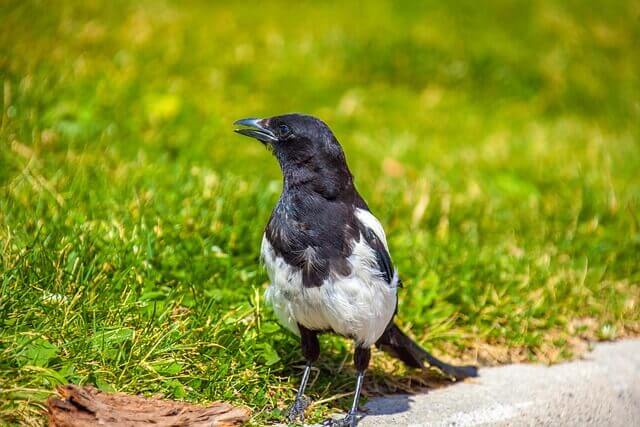
The Black-billed Magpie is an intelligent and social bird known for its striking black and white plumage. It’s native to western North America and can often be spotted in open habitats, including urban areas.
These birds have a length of approximately 18-24 inches (46-61 cm) and a weight of around 5-7.5 ounces (140-214 grams). Their diet includes a variety of foods such as insects, small mammals, fruits, and even carrion. Black-billed Magpies typically build large, domed nests made of sticks and twigs.
The nests are often found in trees, providing shelter for their eggs during incubation, which lasts around 16-21 days. Magpies are highly adaptable birds, which has contributed to their successful coexistence with humans.
| Characteristic | Details |
|---|---|
| Length | 18-24 inches (46-61 cm) |
| Weight | 5-7.5 ounces (140-214 grams) |
| Range | Western North America |
| Habitat | Open habitats, urban areas |
| Diet | Insects, small mammals, fruits, carrion |
| Nest Structure | Large domed nests made of sticks and twigs |
| Materials Used | Sticks, twigs, and plant materials |
| Incubation Period | Approximately 16-21 days |
Eastern Phoebe
The Eastern Phoebe (Sayornis phoebe) is a delightful songbird that graces the landscapes of eastern North America. Measuring approximately 7 inches (18 cm) in length, these small birds sport brownish-gray plumage with a pale belly, making them easily recognizable. Their melodious “fee-bee” call resonates through wooded areas, along riversides, and in suburban regions, a sure sign of spring’s arrival.
Eastern Phoebes are adept flycatchers, primarily preying on insects, especially flies and bees. They perch on branches or wires while hunting, displaying their resourcefulness in finding food. When it comes to nesting, these birds are versatile, constructing open cup-shaped nests from mud and moss.
They choose various surfaces, from building ledges to bridges, demonstrating their adaptability to urban and natural environments. Eastern Phoebes are a cherished symbol of spring and contribute to the rich tapestry of their ecosystems.
| Characteristic | Details |
|---|---|
| Length | 18-24 inches (46-61 cm) |
| Weight | 5-7.5 ounces (140-214 grams) |
| Range | Western North America |
| Habitat | Open habitats, urban areas |
| Diet | Insects, small mammals, fruits, carrion |
| Nest Structure | Large domed nests made of sticks and twigs |
| Materials Used | Sticks, twigs, and plant materials |
| Incubation Period | Approximately 16-21 days |
Rufous Hornero
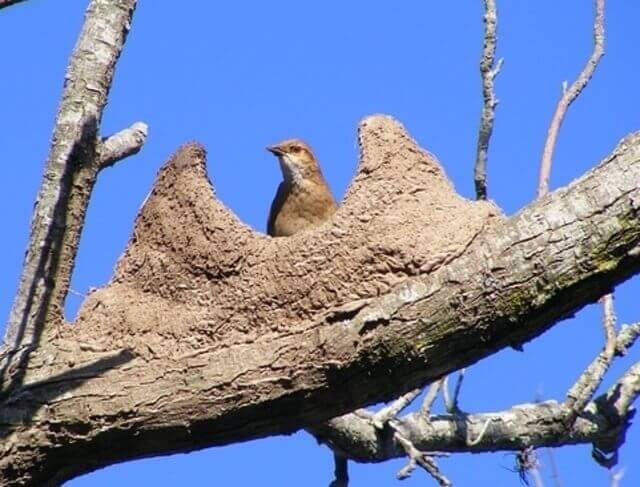
The Rufous Hornero (Furnarius rufus) is a captivating bird native to South America. These birds are known for their rufous-brown plumage and relatively small size, measuring around 8-11 inches (21-29 cm). They primarily inhabit open woodlands and grassy areas, where they forage for insects and seeds.
However, what truly distinguishes them is their remarkable nest-building ability. Rufous Horneros construct unique, dome-shaped nests out of clay and attach them to trees or buildings. These nests resemble traditional ovens, hence their name.
The clay structure offers protection from predators and helps regulate the internal temperature. Beyond their architectural skills, Rufous Horneros are celebrated for their melodious songs and are the national bird of Argentina, carrying cultural significance in the region.
| Characteristic | Details |
|---|---|
| Length | 8-11 inches (21-29 cm) |
| Weight | Approximately 2.5-3 ounces (70-85 grams) |
| Range | South America, primarily in Argentina |
| Habitat | Open woodlands, grassy areas |
| Diet | Insects, seeds, and small invertebrates |
| Nest Structure | Unique dome-shaped nests made of clay |
| Materials Used | Clay and mud |
| Incubation Period | Around 17-18 days |
Cliff Swallow
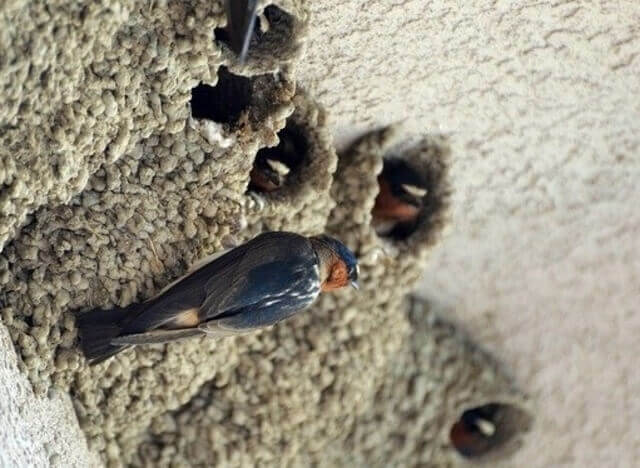
The Cliff Swallow (Petrochelidon pyrrhonota) is a small bird species native to North America. It’s recognized for its remarkable nest-building skills, constructing unique gourd-shaped nests made of mud, clay, and its saliva.
These nests are often found clinging to cliffs, eaves of buildings, or other protected structures. Cliff Swallows have distinctive physical characteristics, including a steel-blue crown and back, a cinnamon-colored forehead and throat, and a pale orange rump.
They are typically 5.9-6.7 inches (15-17 cm) in length and weigh around 0.7-1.1 ounces (20-31 grams). Their diet primarily consists of flying insects, making them important in controlling insect populations. These birds are commonly found in open areas near water and cliffs, making them a fascinating subject for bird enthusiasts.
| Characteristic | Details |
|---|---|
| Length | Approximately 5.9-6.7 inches (15-17 cm) |
| Weight | About 0.7-1.1 ounces (20-31 grams) |
| Range | North America, parts of Central America |
| Habitat | Open areas, near water, cliffs, eaves |
| Diet | Flying insects |
| Nest Structure | Distinctive gourd-shaped mud nests |
| Materials Used | Mud, clay, and their saliva |
| Incubation Period | Around 14-16 days |
Barn Swallow
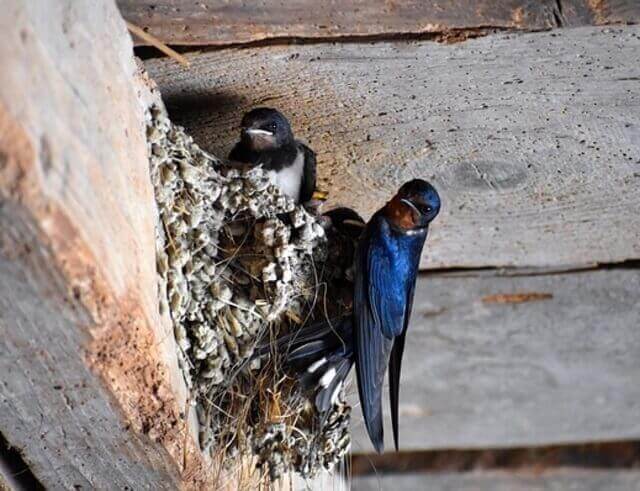
Barn Swallows (Hirundo rustica) are among the most recognizable and widespread swallow species found across the world. They are celebrated for their exceptional agility and aerial acrobatics, often seen swooping and gliding in pursuit of flying insects, which constitute their primary diet.
These birds are distinguishable by their distinctive deep-blue plumage on the upperparts and a rust-colored forehead and throat, with a deeply forked tail. Their slender bodies measure approximately 6.7-7.5 inches (17-19 cm) in length, and they weigh about 0.6-0.7 ounces (17-20 grams).
Barn Swallows prefer nesting near human-made structures, such as barns and open buildings, where they craft cup-shaped mud nests lined with feathers. Their nesting sites can vary from barn rafters to cliff faces, reflecting their adaptability to diverse habitats.
| Characteristic | Details |
|---|---|
| Length | Approximately 6.7-7.5 inches (17-19 cm) |
| Weight | Around 0.6-0.7 ounces (17-20 grams) |
| Range | Found worldwide, except polar regions |
| Habitat | Open areas, near water, human-made structures |
| Diet | Insects, especially flying ones |
| Nest Structure | Cup-shaped nests made of mud and lined with feathers |
| Materials Used | Mud, grass, feathers |
| Incubation Period | About 12-17 days |
Cave Swallow
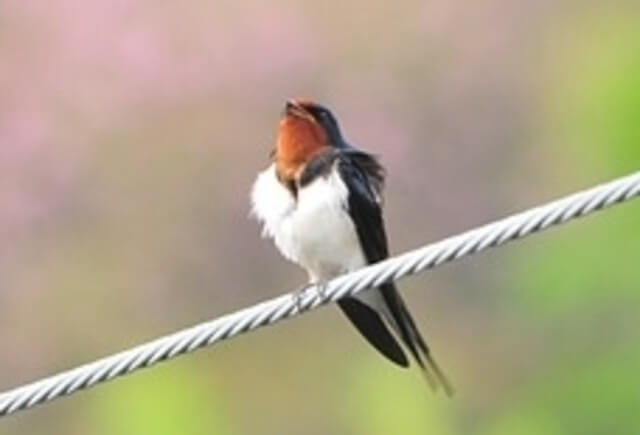
The Cave Swallow (Petrochelidon fulva) is a remarkable bird species distinguished by its striking blue plumage and distinct white rump. These swallows are native to North and Central America, and they exhibit remarkable adaptability by nesting in a variety of locations, including caves, cliffs, and even under bridges and building overhangs.
Their diet primarily consists of flying insects, and they are known for their agile flight, expertly catching prey mid-air. Cave Swallows are skilled builders, crafting cup-shaped nests using a mixture of mud and saliva. They incorporate plant materials into their nests as well.
During the incubation period, which lasts approximately 14-16 days, these swallows diligently care for their eggs and young. These adaptable birds are fascinating to observe, and their presence contributes to natural pest control in the areas they inhabit.
| Characteristic | Details |
|---|---|
| Length | Approximately 5.5 inches (14 cm) |
| Weight | About 0.6 ounces (17 grams) |
| Range | North and Central America |
| Habitat | Caves, cliffs, bridges, urban areas |
| Diet | Flying insects |
| Nest Structure | Cup-shaped nests made of mud and saliva |
| Materials Used | Mud, plant material, saliva |
| Incubation Period | Approximately 14-16 days |
American Flamingo
The American Flamingo (Phoenicopterus ruber) is an iconic and easily recognizable bird species due to its striking pink plumage, distinctive long neck, and slender legs. Native to the Americas, these birds are commonly found in tropical and subtropical regions of Central and South America, as well as the Caribbean.
American Flamingos are filter feeders, primarily consuming algae, plankton, and small aquatic invertebrates. They inhabit various wetland environments, including coastal lagoons, salt flats, and shallow coastal areas. Their nesting sites are often located on mudflats or sandbars near water bodies.
Nests of American Flamingos are constructed from mud and are often cone-shaped mounds. They use a combination of their bills and feet to build and maintain these nests. The incubation period typically lasts around 28-32 days. These social birds are known for their graceful and synchronized group movements.
| Characteristic | Details |
|---|---|
| Length | Approximately 45-50 inches (115-140 cm) |
| Weight | 4-9 pounds (1.8-4.1 kg) |
| Range | Southern Florida, Mexico, the Caribbean, and Central and South America |
| Habitat | Coastal lagoons, salt flats, and shallow coastal areas |
| Diet | Algae, plankton, aquatic invertebrates |
| Nest Structure | Cone-shaped mounds made of mud |
| Materials Used | Mud and clay |
| Incubation Period | Approximately 28-32 days |
Apostlebird
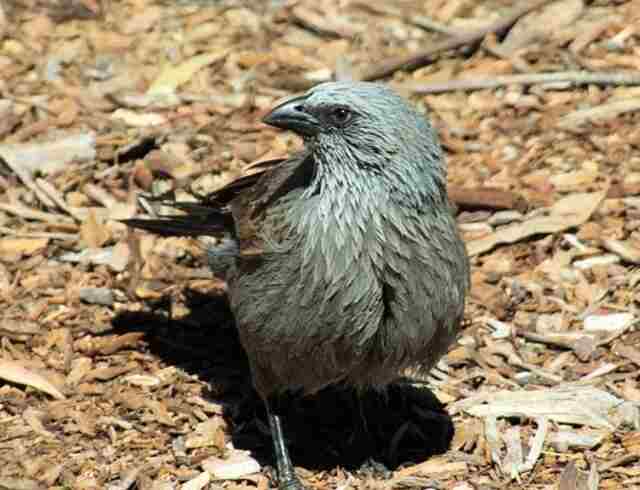
The Apostlebird (Struthidea cinerea) is a distinctive and sociable bird native to Australia. These birds are known for their gregarious behavior, often seen in family groups known as “communities.” They primarily inhabit open woodlands, savannahs, and agricultural areas, favoring a mix of trees and grassy spaces.
Apostlebirds are omnivorous and feed on a wide variety of food items, including insects, fruits, seeds, and small vertebrates. Their nesting sites are typically located in shrubs and trees, where they construct bowl-shaped nests from twigs, leaves, and other plant materials. These nests are relatively large, accommodating the communal nature of these birds.
Apostlebirds have distinct dark gray plumage with pale eyes and bills. They are often observed in noisy groups of up to a dozen or more birds, displaying cooperative breeding and foraging behaviors. The incubation period for their eggs is around 17-18 days.
| Characteristic | Details |
|---|---|
| Length | Approximately 12-14 inches (30-35 cm) |
| Weight | 1.5-2.8 ounces (42-80 grams) |
| Range | Eastern and southeastern Australia |
| Habitat | Open woodlands, savannahs, and agricultural areas |
| Diet | Insects, fruits, seeds, small vertebrates |
| Nest Structure | Bowl-shaped nests made of twigs, leaves, and plant materials |
| Materials Used | Twigs, leaves, grasses |
| Incubation Period | Approximately 17-18 days |
Black Phoebe
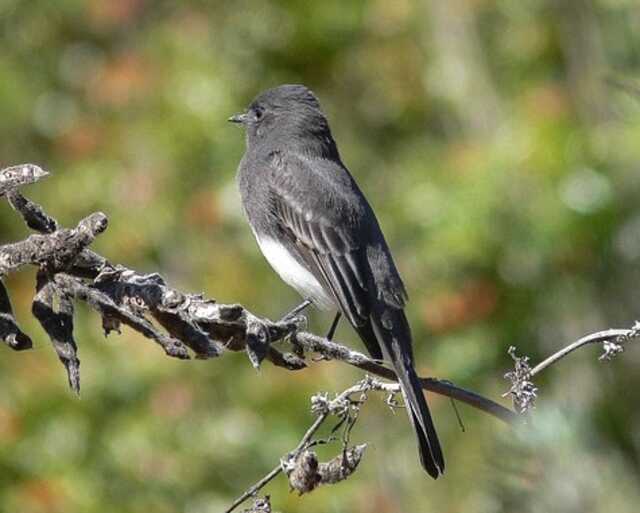
The Black Phoebe (Sayornis nigricans) is a charming bird found in the western regions of North and South America. These birds are relatively small, measuring about 6-7 inches in length, and are known for their striking black plumage, white underparts, and a distinctive white patch on the wings. They inhabit various environments, from riparian areas to urban settings.
Black Phoebes primarily feed on insects, especially flies, beetles, and aquatic insects, which they catch by darting out from perches near water sources. They’re often seen perched near ponds, streams, or other bodies of water.
These birds construct cup-shaped nests in a variety of locations, such as cliffs, bridges, buildings, and even caves. They use a mixture of mud, vegetation, and fine materials to build their nests. The female lays 3-4 eggs, and both parents take turns incubating them. The incubation period typically lasts about 16-17 days.
| Characteristic | Details |
|---|---|
| Length | 6-7 inches (15-18 cm) |
| Weight | Approximately 0.6-0.7 ounces (17-20 grams) |
| Range | Western North and South America |
| Habitat | Riparian areas, urban areas |
| Diet | Insects, especially flies and aquatic insects |
| Nest Structure | Cup-shaped nests made of mud, vegetation, and fine materials |
| Materials Used | Mud, vegetation, fine materials |
| Incubation Period | Approximately 16-17 days |
Hamerkops
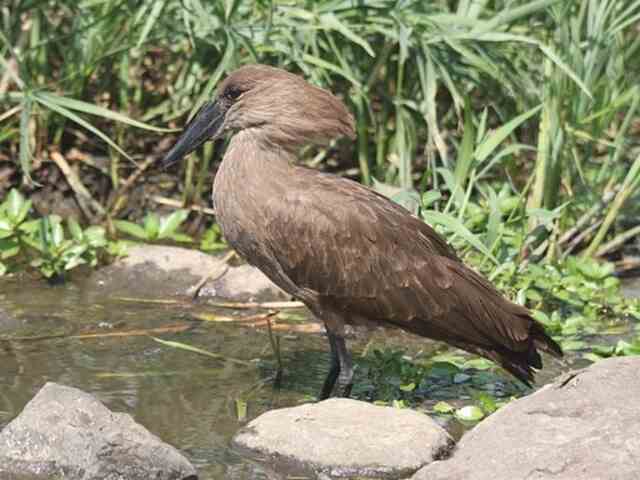
The Hamerkop (Scopus umbretta) is a captivating bird species found in sub-Saharan Africa. What sets it apart is its distinctive hammer-shaped crest on top of its head, giving it the name “hamerkop,” derived from the Afrikaans term for “hammerhead.”
These birds exhibit great adaptability to various wetland habitats, including marshes, swamps, and the banks of rivers and lakes. They can also thrive in human-altered environments. Hamerkops are proficient hunters, preying on aquatic insects, fish, amphibians, and even small mammals. Their long, sharp beaks make them adept at catching prey.
Known for their remarkable nests, Hamerkops construct large, intricate structures using sticks, grass, and mud. These nests can grow up to 5 feet (1.5 meters) in diameter and feature multiple chambers, including a central living space for incubating eggs. The incubation period typically lasts around 28 days.
| Characteristic | Details |
|---|---|
| Length | Approximately 22 inches (56 cm) |
| Weight | 1.1-1.5 pounds (500-700 grams) |
| Range | Sub-Saharan Africa |
| Habitat | Wetlands, including marshes, swamps, and riverbanks |
| Diet | Aquatic insects, fish, amphibians, small mammals |
| Nest Structure | Large, domed nests made of sticks, grass, and mud |
| Materials Used | Sticks, grass, mud, sometimes incorporating various objects |
| Incubation Period | Approximately 28 days |
Spotted Morning Thrush

The Spotted Morning Thrush (Cichicichasoma maculatum), also known as the Olive Thrush, is a bird native to southern Africa. These medium-sized thrushes are known for their rich, olive-brown plumage with striking spotted patterns on their underparts. They are commonly found in gardens, forests, and woodlands, often near human settlements.
Spotted Morning Thrushes primarily feed on insects, earthworms, and fruits, making them omnivorous. They forage for food on the ground, using their sharp beaks to extract insects from leaf litter.
When it comes to nesting, these birds construct cup-shaped nests made of various materials like leaves, twigs, and grass. They often place their nests in trees or shrubs, ensuring a hidden and secure location. The female lays 2-3 eggs, which are incubated for around 14 days.
| Characteristic | Details |
|---|---|
| Length | Approximately 9-10 inches (23-25 cm) |
| Weight | Around 2.5-3 ounces (70-85 grams) |
| Range | Southern Africa |
| Habitat | Gardens, forests, and woodlands |
| Diet | Insects, earthworms, and fruits |
| Nest Structure | Cup-shaped nests made of leaves, twigs, and grass |
| Materials Used | Leaves, twigs, grass |
| Incubation Period | Approximately 14 days |
White-winged Chough

The White-winged Chough (Corcorax melanorhamphos) is a distinctive and intelligent bird native to eastern Australia. These choughs are known for their striking appearance, characterized by black plumage with distinctive white patches on their wings, and red eyes.
White-winged Choughs are highly social birds that live in cooperative family groups. They are often found in open woodlands, forests, and shrubby areas. These birds are omnivorous, feeding on a wide range of items such as insects, seeds, and fruits.
When it comes to nesting, White-winged Choughs are cooperative breeders, with the whole group participating in building the large, cup-shaped nests made of sticks, mud, and grass. These nests are often located in trees or shrubs, providing a safe and secure environment for raising their young.
| Characteristic | Details |
|---|---|
| Length | Approximately 18 inches (45 cm) |
| Weight | Around 200-300 grams |
| Range | Eastern Australia |
| Habitat | Open woodlands, forests, shrubby areas |
| Diet | Insects, seeds, fruits |
| Nest Structure | Cup-shaped nests made of sticks, mud, and grass |
| Materials Used | Sticks, mud, grass |
| Incubation Period | Approximately 21 days |
Pros and Cons of Mud Nest Building
Advantages of Mud Nest Building:
- Natural Insulation: Mud nests offer exceptional insulation against extreme temperatures, shielding eggs and nestlings from the heat of the day and the cold of the night.
- Predator Deterrence: The robust structure of mud nests provides added protection from predators, making it harder for them to access the nests.
- Adaptive Camouflage: The earthy colors of mud blend seamlessly with the environment, camouflaging the nest and its inhabitants.
- Sustainability: Constructing nests from locally sourced mud is environmentally sustainable, reducing the need for additional materials.
- Low Maintenance: Mud nests are easy to maintain; birds can quickly repair damage and make necessary adjustments.
Challenges of Mud Nest Building:
- Dependency on Resources: The availability of suitable mud sources is crucial. Climate and local terrain can influence nest quality.
- Vulnerability to Weather: Heavy rains or flooding can damage mud nests, potentially jeopardizing the nestlings.
- Competition for Resources: As mud is a finite resource, competition for mud sources may arise among bird species.
- Energy Expenditure: Building mud nests requires substantial energy and time investments for collecting and shaping the mud.
- Limited Reusability: Unlike twig nests, mud nests are not easily reusable for future breeding seasons.
Understanding the pros and cons of mud nest building is essential for appreciating the remarkable adaptations of birds. These nests, shaped from a mixture of instinct and environmental conditions, represent a fascinating aspect of avian behavior and survival strategies.
Material Used for Building a Mud Nest
Exploring the materials birds use to construct their mud nests provides intriguing insights into avian engineering and adaptability.
1. Mud:
- Versatile Foundation: Mud serves as the foundational material for these nests. Birds expertly blend mud with natural elements like saliva, creating an adhesive mixture that forms the nest’s structure.
2. Saliva:
- Binding Agent: Birds employ their saliva not only to aid in binding but also to enhance the mud’s adhesive properties. This ensures that the nest remains stable and durable.
3. Natural Fibers:
- Structural Reinforcement: Birds sometimes incorporate natural fibers, such as plant stems, twigs, or feathers, to strengthen the nest’s framework, providing the necessary support for their offspring.
4. Feathers and Soft Materials:
- Interior Comfort: To create a snug and secure environment for their eggs and nestlings, some species add feathers and soft plant materials to line the interior of the nest.
5. Additional Elements:
- Adaptive Accessories: Depending on the bird species and its surroundings, they may integrate various items like grass, lichen, moss, or small stones into the nest. These additions not only contribute to structural integrity but also offer camouflage and protection.
Understanding these building materials provides valuable insights into the resourcefulness and adaptability of birds in constructing their mud nests. These nests serve as a testament to the ingenious ways in which birds utilize available resources to create safe havens for their young.
How Birds Build Mud Nests?
Get ready to witness some avian artistry at work! When it comes to building mud nests, birds are nothing short of master craftsmen, using their beaks, feet, and even their own saliva to create intricate and sturdy structures that can withstand the elements. First, the bird typically selects a suitable location for its nest, such as the side of a cliff, a tree branch, or the eaves of a building.
Then, it begins the process of gathering materials – usually a mixture of mud, twigs, grass, and other organic matter. With its beak, the bird carefully molds the mud into the desired shape, using its feet to compact the materials and add stability.
But that’s not all – some bird species take their nest-building skills to the next level by using their own saliva to bind the materials together. That’s right – a bird’s spit can actually act as a natural glue, helping to hold the nest together and create a waterproof barrier that keeps the eggs and chicks inside safe and dry.
As the nest takes shape, the bird will continue to add more layers of materials, carefully shaping and sculpting the structure to fit its needs. Some species even create multiple chambers within their nests, allowing them to lay eggs and raise their young in separate compartments.
And let’s not forget about the intricate details – many bird species add finishing touches to their mud nests, such as bits of moss, feathers, and even discarded snake skins, to make them more comfortable and camouflaged.
In the end, a bird’s mud nest is not just a simple structure, but a true work of art, reflecting the creativity, ingenuity, and adaptability of these incredible creatures. So the next time you spot a mud nest perched high in a tree or nestled against a cliff, take a moment to marvel at the avian architect who built it.
Frequently Asked Questions
How to get rid of mud nest birds?
- Wait for Nesting Season to End: Removing nests during the breeding season is not recommended as it can harm the birds and is illegal in most places. Wait until the birds have finished nesting and the nests are abandoned.
- Wear Gloves: When handling nests, wear gloves to protect yourself from potential contaminants in the nest and to maintain hygiene.
- Remove the Nest: Carefully remove the abandoned nest and any debris from the nesting area.
- Clean the Area: Thoroughly clean the nesting area to eliminate any nesting material and bird droppings. This helps deter birds from returning to the same spot.
- Seal Entry Points: If the birds accessed your home through openings, seal these entry points to prevent future nesting.
- Maintain Regular Cleaning: To deter birds from returning, maintain regular cleaning and maintenance of potential nesting sites.
Remember, it’s essential to wait until the nesting season is over to avoid harming the birds and ensure your actions comply with local regulations.
How to stop swallows nesting on your house?
Preventing swallows from nesting on your house involves installing visual deterrents, like reflective objects or bird spikes. Additionally, ensure all potential nest sites are sealed during the off-season.
How to stop swallows nesting under eaves?
You can discourage swallows from nesting under eaves by blocking access with mesh or netting. Implementing visual deterrents like reflective tape can also help keep them away.
When can you knock down a swallows nests?
It’s best to remove swallows’ nests when they are unoccupied, typically during their migration season. Check local regulations, as some species are protected, and removing their nests may require permits.
How to keep swallows out of sheds?
To prevent swallows from nesting in sheds, ensure all openings are closed. Use netting or mesh on windows and ventilation holes, and install visual deterrents like owl decoys or reflective tape.
How do you stop birds from building mud nests?
What bird builds a mud nest?
Several bird species construct mud nests. One notable example is the Barn Swallow (Hirundo rustica), known for its cup-shaped mud nests often found in barns, under bridges, and other structures. These nests are typically lined with grass and feathers, providing a cozy environment for raising their young.
Birds that build nests on the side of the house
Barn Swallows are famous for building nests on the sides of houses, often under eaves and overhangs. Their choice of nesting sites provides protection from the elements and natural predators.
Birds that build mud nests on porches
To deter birds from building mud nests, you can clean and seal potential nest sites, install bird spikes, and use visual deterrents like hanging strips of reflective material near nesting areas. Be sure to act when the birds are not nesting to avoid harming them.
If you notice mud nests on your porch, chances are they were constructed by Barn Swallows. These nests are expertly attached to vertical surfaces, offering a safe place for their chicks to grow.
How to identify a mud bird nest
Mud nests are generally easy to recognize due to their distinctive cup shape and the use of mud pellets. These nests can be built by various bird species, including House Wrens, which may add some plant materials for lining.
Name the bird that builds a nest out of mud
The Northern Rough-winged Swallow (Stelgidopteryx serripennis) is one bird known for creating nests from mud pellets. These swallows prefer vertical crevices or holes in structures, using their mud nests for raising their young.
Small birds that make mud nests
House Wrens (Troglodytes aedon), renowned for their small size, are adept at constructing mud nests, usually in natural cavities or man-made birdhouses. Their nests are small and well-crafted.
Birds that build mud houses
Barn Swallows can be considered builders of “mud houses” due to the way they construct their nests under eaves, creating a cozy shelter for their nestlings.
Birds that build mud nests under bridges
Cliff Swallows (Petrochelidon pyrrhonota) are known for their preference for nesting under bridges and overpasses. They create gourd-shaped mud nests, often in large colonies, offering protection from predators.
Bird nest with mud and straw
Nests made with mud and straw are commonly associated with House Sparrows (Passer domesticus). These adaptable birds often incorporate a mix of materials to create their nests, including twigs and grass.
Birds that build mud nests in Texas
In Texas, you can observe Barn Swallows, Northern Rough-winged Swallows, and Cliff Swallows actively constructing mud nests, especially under eaves and sheltered areas.
Oklahoma birds that build mud nests
Oklahoma shares many bird species with Texas, so Barn Swallows and Cliff Swallows are common nest builders in the state. Their nesting habits are similar to those observed in Texas.
Do sparrows make mud nests?
Some sparrows, such as House Sparrows, utilize mud in their nest construction, but they also incorporate other materials like twigs and grass. The nests of sparrows are generally bulkier and less refined than those of swallows.
Birds that make mud nests in Texas
Barn Swallows, Northern Rough-winged Swallows, and Cliff Swallows are examples of birds commonly building mud nests in various parts of Texas. These nests serve as safe havens for their chicks.
What birds make mud nests under bridges?
Cliff Swallows are well-known for constructing mud nests under bridges and overpasses, making them ideal subjects for this nesting behavior.
Birds that make clay nests
American Cliff Swallows are notable for creating nests from clay mixed with their saliva. These unique nests are usually gourd-shaped and are commonly seen in colonies.
Birds that build mud nests in Georgia
Bird species in Georgia, such as Barn Swallows, Northern Rough-winged Swallows, and Cliff Swallows, share similar nesting behaviors to those observed in Texas. Their nests are often found in sheltered locations.
What does a mud wren nest look like?
A mud wren nest is typically a domed structure with an entrance hole on one side. These nests are composed of mud, plant materials, and other debris, providing an insulated and secure space for wrens to raise their young.
Why are birds putting mud on my house?
Birds, like swallows, apply mud to create nests. If you find mud on your house, it’s likely because swallows are building nests there. These birds select structures like houses to create sheltered and safe nesting sites for their chicks.

